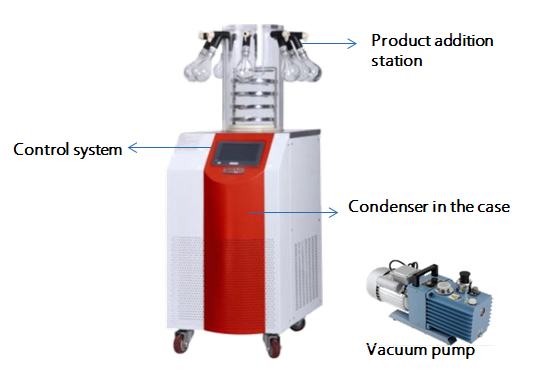Manifold Freeze Dryers
Overview of Manifold Freeze Dryers
A manifold freeze dryer is often used as the entry equipment into freeze drying. Researchers who are looking for an active pharmaceutical ingredient or processing HPLC fractions often use a manifold freeze dryer during their initial steps in the lab . The decision to purchase this type of freeze dryer is typically based on criteria that includes, but is not limited to:
1. -Number of users in the lab is usually high and the amount of product they are making is small
2. -Large numbers of small individual samples
3. Smaller equipment budget
4. Cell banking type of facility
5. Freeze dried product not for commercial use at this stage
6. Very early stage research
7. Minimally critical product processing required
Although large numbers of manifold systems are purchased and are quite adequate for the task at hand, it is important to understand that using a manifold type freeze dryer has significant limitations with regard to the freeze drying process. Ultimately the operator has no control over the freeze drying process, as they would in the more expensive and complex tray or shelf type freeze dryer. However, there are steps that can be taken to create a greater success on a manifold freeze dryer when that equipment is used. This article will explain basic manifold systems, their limitations and strengths and how to mitigate some of the problems that may occur during the freeze drying process.
Understanding the Parts of a Manifold Freeze Dryer
Like all freeze dryers a manifold freeze dryer has 4 basic components. These are:
· Product addition station
· Condenser
· Vacuum
· Control System

Product Addition Station
The product addition station is the piece of the equipment that introduces the product to the freeze dryer. In the case of a manifold system the product containers are usually flasks. The product is placed in the flask and most typically statically frozen in a low temperature bath or a freezer. We will discuss the freezing options in more depth later in this tech note.
The Condenser
The condenser in almost all modern freeze dryers is a refrigerated surface that serves to drive the sublimation process by creating a
lower pressure area in the dryer. The condenser also serves to trap moisture/solvents and thus preventing them from going to the vacuum pump. Most freeze dryers are offered in a “single stage”
(single compressor), “two stage” (two compressors) or “two stage blended” (two compressors with a special blend of gas). Maximum low temperature ranges of – 48C (for a single stage unit) to -85C (two stage system) are not uncommon. Some blended systems can achieve even lower temperatures, such as -105C. It is imperative to understand that the vapor pressure over ice is not a linear curve. As temperature gets lower and lower the law of diminishing returns applies.
System Vacuum and the Vacuum Pump
The vapor pressure over ice at -48C is equivalent to 37.8 mT. At -85C it is 0.15 mT which translates to a difference of approximately 37.65
mT. You can see however that below -85C a lower temperature only creates a very small incremental decrease in pressure –in the tenths and hundredths of milliTorr. Indeed, most vapor pressure over ice tables that are published stop at approximately -80C because at lower temperatures the pressure differential becomes insignificant.
The vacuum pump for most manifold freeze dryers is a two stage rotary vane oil sealed vacuum pump. The vacuum pumps sole purpose during most of the freeze drying process is to remove non-condensable vapors (nitrogen, oxygen, carbon dioxide et al) from the freeze dryer. By removing the non-condensable gasses in the system the vacuum pump essentially helps to create the environment for sublimation (ice to vapor without going through the liquid phase)
to occur. Because all freeze dryers are have leaks (virtual leaks–outgassing from stainless steel (yes it may outgas), gaskets, acrylics et al and real–little pinhole leaks of various configurations and locations within the system, such at the vacuum tube hook up between the condenser and the vacuum pump) the vacuum pump is operated continuously throughout the freeze drying cycle. Theoretically IF the freeze dryer were totally and completely leak free, once the vacuum pump performed the initial pull down it could essentially be turned off and not used any further until the end of the run. In real life this is not possible.
The Control System
The control system of a freeze dryer is becoming increasingly important in the differentiation of one freeze dryer to another. The amount of automation and user friendliness may vary greatly from one machine to another. Regardless of the brand, it is recommended that automatic on and automatic off are part of the controller’s capabilities. In laboratories where manifold dryers are most commonly used, freeze drying is a means to an end and simply another process in a long list of processes that people must use to accomplish their goals. Not everyone is a freeze dryer expert. Having the automatic on and off functions helps to ensure that the proper start-up and shut-down sequences are used to provide system protection and longevity.
Post time: Jan-21-2022




